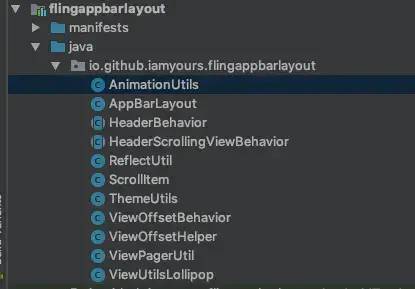我们知道,Desgin包中的AppBarLayout配合CollapsingToolbarLayout可以实现折叠效果。但是顶部在快速滑动到折叠状态时,底部的NestedScrollChild不会因为惯性跟着滑动,整个滑动过程瞬间停止,给人一种很不流畅的感觉。为了能让我们的AppBarLayout能Fling更流畅,我们需要在重新修改源码,定制一个FlingAppBarLayout,能够实现类似饿了么首页效果 其中ScrollItem,ReflectUtil,ViewPagerUtil为我们自己定义的,其他都是design包拷贝的。
其中ScrollItem,ReflectUtil,ViewPagerUtil为我们自己定义的,其他都是design包拷贝的。
通过前面三块代码,我们知道AppBarLayout的Fling效果是通过scroller实现的,滑动的边界时通过minOffset和maxOffset来控制的,当滑动的offset超出范围时,scroller调用computeScrollerOffset就为false,顶部view就停止移动了。因此为了能让AppBarLayout在向上滑动到minOffset边界时不停止移动,把这个minOffset保存到FlingRunnable中,在scroller.fling方法中这个更小的offset,这个在滑动到minOffset时,computeScrollerOffset就不会为false,并且在FlingRunnable中因为有minOffset,我们可以在mScroller.computeScrollOffset里判断是否滑出边界,通过差值,继续滑动底部的可滑动布局。
在FlingRunnable中新增ScrollItem字段用于处理scroll逻辑
好了,基本的滑动逻辑处理完了,我们自己的AppBarLayout可以惯性fling了。会看ScrollItem代码,我加了stopScroll的逻辑。那是因为在底部recyclerView或NestedScrollView快速向下滑动至AppBarLayout展开,而这时在AppBarLayout想要快速向上滑动,应为底部正在滑动,导致两者冲突,不能正常向上滑动,所以AppBarLayout在向上快速滑动时,要停止底部滑动。通过NestedScrollView和RecyclerView的源码,我们找到控制滑动逻辑的OverScroller和ViewFlinger,我们可以通过反射来停止对应的滑动。源码地址:https://github.com/iamyours/FlingAppBarLayout到这里就结束啦。往期精彩回顾:

思路
我们知道AppBarLayout之所以能够有折叠效果,是因为有一个默认的Behavior,而且AppBarLayout在快速滑动时,布局也能够快速展开和收缩,因此可以猜测内部有可能处理了Fling事件。通过源码,找到对应的Behavior,它继承自HeaderBehavior,通过onTouchEvent方法,找到了对应对于Fling事件的处理 case MotionEvent.ACTION_UP: if (mVelocityTracker != null) { mVelocityTracker.addMovement(ev); mVelocityTracker.computeCurrentVelocity(1000); float yvel = mVelocityTracker.getYVelocity(mActivePointerId); fling(parent, child, -getScrollRangeForDragFling(child), 0, yvel); } final boolean fling(CoordinatorLayout coordinatorLayout, V layout, int minOffset, int maxOffset, float velocityY) { if (mFlingRunnable != null) { layout.removeCallbacks(mFlingRunnable); mFlingRunnable = null; } if (mScroller == null) { mScroller = new OverScroller(layout.getContext()); } mScroller.fling( 0, getTopAndBottomOffset(), // curr 0, Math.round(velocityY), // velocity. 0, 0, // x minOffset, maxOffset); // y if (mScroller.computeScrollOffset()) { mFlingRunnable = new FlingRunnable(coordinatorLayout, layout); ViewCompat.postOnAnimation(layout, mFlingRunnable); return true; } else { onFlingFinished(coordinatorLayout, layout); return false; } } private class FlingRunnable implements Runnable { private final CoordinatorLayout mParent; private final V mLayout; FlingRunnable(CoordinatorLayout parent, V layout) { mParent = parent; mLayout = layout; } @Override public void run() { if (mLayout != null && mScroller != null) { if (mScroller.computeScrollOffset()) { setHeaderTopBottomOffset(mParent, mLayout, mScroller.getCurrY()); // Post ourselves so that we run on the next animation ViewCompat.postOnAnimation(mLayout, this); } else { onFlingFinished(mParent, mLayout); } } } }具体实现
首先,我们把design中的AppBarLayout源码复制到自己的package中,引入报红的相关文件,具体如下: 其中ScrollItem,ReflectUtil,ViewPagerUtil为我们自己定义的,其他都是design包拷贝的。
其中ScrollItem,ReflectUtil,ViewPagerUtil为我们自己定义的,其他都是design包拷贝的。通过前面三块代码,我们知道AppBarLayout的Fling效果是通过scroller实现的,滑动的边界时通过minOffset和maxOffset来控制的,当滑动的offset超出范围时,scroller调用computeScrollerOffset就为false,顶部view就停止移动了。因此为了能让AppBarLayout在向上滑动到minOffset边界时不停止移动,把这个minOffset保存到FlingRunnable中,在scroller.fling方法中这个更小的offset,这个在滑动到minOffset时,computeScrollerOffset就不会为false,并且在FlingRunnable中因为有minOffset,我们可以在mScroller.computeScrollOffset里判断是否滑出边界,通过差值,继续滑动底部的可滑动布局。
mScroller.fling( 0, getTopAndBottomOffset(), // curr 0, Math.round(velocityY), // velocity. 0, 0, // x minOffset-5000, maxOffset); // 设置一个很大的值,在向上滑动时不会因为低于minOffset而停止滑动 class FlingRunnable implements Runnable { private final CoordinatorLayout mParent; private final V mLayout; private int minOffset; FlingRunnable(CoordinatorLayout parent, V layout, int min) { mParent = parent; mLayout = layout; minOffset = min; } @Override public void run() { if (mLayout != null && mScroller != null) { if (mScroller.computeScrollOffset()) { int currY = mScroller.getCurrY(); if (currY < 0 && currY < minOffset) { scrollNext(minOffset - currY); setHeaderTopBottomOffset(mParent, mLayout, minOffset); } else { setHeaderTopBottomOffset(mParent, mLayout, currY); } // Post ourselves so that we run on the next animation ViewCompat.postOnAnimation(mLayout, this); } else { onFlingFinished(mParent, mLayout); } } } }在构造FlingRunnable时传入minOffset
final boolean fling(CoordinatorLayout coordinatorLayout, V layout, int minOffset, int maxOffset, float velocityY) { if (mFlingRunnable != null) { layout.removeCallbacks(mFlingRunnable); mFlingRunnable = null; } if (mScroller == null) { mScroller = new OverScroller(layout.getContext()); } mScroller.fling( 0, getTopAndBottomOffset(), // curr 0, Math.round(velocityY), // velocity. 0, 0, // x minOffset-5000, maxOffset); // y if (mScroller.computeScrollOffset()) { mFlingRunnable = new FlingRunnable(coordinatorLayout, layout, minOffset); ViewCompat.postOnAnimation(layout, mFlingRunnable); return true; } else { ... } }在FlingRunnable中新增ScrollItem字段用于处理scroll逻辑
class FlingRunnable implements Runnable { private final CoordinatorLayout mParent; private final V mLayout; private int minOffset; private ScrollItem scrollItem; FlingRunnable(CoordinatorLayout parent, V layout, int min) { mParent = parent; mLayout = layout; minOffset = min; initNextScrollView(parent); } private void initNextScrollView(CoordinatorLayout parent) { int count = parent.getChildCount(); for (int i = 0; i < count; i++) { View v = parent.getChildAt(i); CoordinatorLayout.LayoutParams lp = (CoordinatorLayout.LayoutParams) v.getLayoutParams(); if (lp.getBehavior() instanceof AppBarLayout.ScrollingViewBehavior) { scrollItem = new ScrollItem(v); } } @Override public void run() { if (mLayout != null && mScroller != null) { if (mScroller.computeScrollOffset()) { int currY = mScroller.getCurrY(); if (currY < 0 && currY < minOffset) { scrollItem.scroll(minOffset - currY); //处理逻辑在ScrollItem中 setHeaderTopBottomOffset(mParent, mLayout, minOffset); } else { setHeaderTopBottomOffset(mParent, mLayout, currY); } // Post ourselves so that we run on the next animation ViewCompat.postOnAnimation(mLayout, this); } else { onFlingFinished(mParent, mLayout); } } }}public class ScrollItem { private int type; //1: NestedScrollView 2:RecyclerView private WeakReference scrollViewRef; private WeakReference layoutManagerRef; public ScrollItem(View v) { findScrollItem(v); } /** * 查找需要滑动的scroll对象 * * @param v */ protected boolean findScrollItem(View v) { if (findCommonScroll(v)) return true; if (v instanceof ViewPager) { View root = ViewPagerUtil.findCurrent((ViewPager) v); if (root != null) { View child = root.findViewWithTag("fling"); return findCommonScroll(child); } } return false; } private boolean findCommonScroll(View v) { if (v instanceof NestedScrollView) { type = 1; scrollViewRef = new WeakReference((NestedScrollView) v); stopScroll(scrollViewRef.get()); return true; } if (v instanceof RecyclerView) { RecyclerView.LayoutManager lm = ((RecyclerView) v).getLayoutManager(); if (lm instanceof LinearLayoutManager) { LinearLayoutManager llm = (LinearLayoutManager) lm; type = 2; layoutManagerRef = new WeakReference(llm); stopScroll((RecyclerView) v); return true; } } return false; } /** * 停止NestedScrollView滚动 * * @param v */ private void stopScroll(NestedScrollView v) { try { Field field = ReflectUtil.getDeclaredField(v, "mScroller"); if (field == null) return; field.setAccessible(true); OverScroller scroller = (OverScroller) field.get(v); if (scroller != null) scroller.abortAnimation(); } catch (Exception e) { e.printStackTrace(); } } /** * 停止RecyclerView滚动 * * @param */ private void stopScroll(RecyclerView rv) { try { Field field = ReflectUtil.getDeclaredField(rv, "mViewFlinger"); if (field == null) return; field.setAccessible(true); Object obj = field.get(rv); if (obj == null) return; Method method = obj.getClass().getDeclaredMethod("stop"); method.setAccessible(true); method.invoke(obj); } catch (Exception e) { e.printStackTrace(); } } public void scroll(int dy) { if (type == 1) { scrollViewRef.get().scrollTo(0, dy); } else if (type == 2) { layoutManagerRef.get().scrollToPositionWithOffset(0, -dy); } }}public class ViewPagerUtil { public static View findCurrent(ViewPager vp) { int position = vp.getCurrentItem(); PagerAdapter adapter = vp.getAdapter(); if (adapter instanceof FragmentStatePagerAdapter) { FragmentStatePagerAdapter fsp = (FragmentStatePagerAdapter) adapter; return fsp.getItem(position).getView(); } else if (adapter instanceof FragmentPagerAdapter) { FragmentPagerAdapter fp = (FragmentPagerAdapter) adapter; return fp.getItem(position).getView(); } return null; }}好了,基本的滑动逻辑处理完了,我们自己的AppBarLayout可以惯性fling了。会看ScrollItem代码,我加了stopScroll的逻辑。那是因为在底部recyclerView或NestedScrollView快速向下滑动至AppBarLayout展开,而这时在AppBarLayout想要快速向上滑动,应为底部正在滑动,导致两者冲突,不能正常向上滑动,所以AppBarLayout在向上快速滑动时,要停止底部滑动。通过NestedScrollView和RecyclerView的源码,我们找到控制滑动逻辑的OverScroller和ViewFlinger,我们可以通过反射来停止对应的滑动。源码地址:https://github.com/iamyours/FlingAppBarLayout到这里就结束啦。往期精彩回顾:
Android实现短信验证码自动填充功能
Android仿echo精美弹幕功能
Android实现头像重叠排列功能
Android仿QQ个性标签功能
Android仿QQ侧滑删除的功能







 本文介绍如何在Android中自定义AppBarLayout,优化Fling操作使其更流畅。通过在构造FlingRunnable时传入minOffset,实现更顺滑的折叠效果。同时文章还提及了Android平台上的其他开发技巧,如短信验证码自动填充、精美弹幕功能、头像重叠排列、以及QQ风格的侧滑删除和个性标签功能。
本文介绍如何在Android中自定义AppBarLayout,优化Fling操作使其更流畅。通过在构造FlingRunnable时传入minOffset,实现更顺滑的折叠效果。同时文章还提及了Android平台上的其他开发技巧,如短信验证码自动填充、精美弹幕功能、头像重叠排列、以及QQ风格的侧滑删除和个性标签功能。
















 1758
1758

 被折叠的 条评论
为什么被折叠?
被折叠的 条评论
为什么被折叠?








